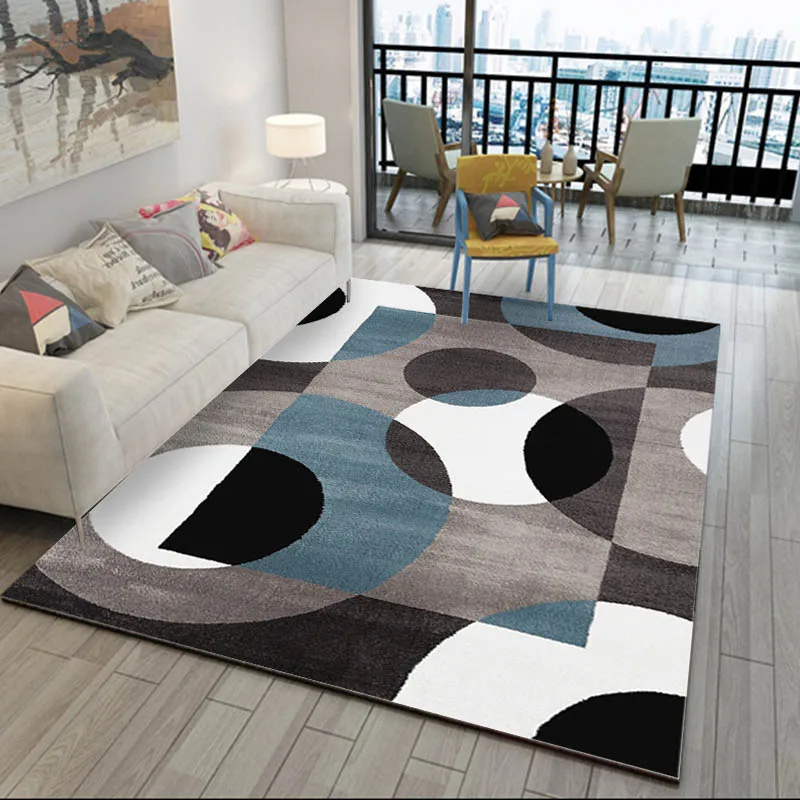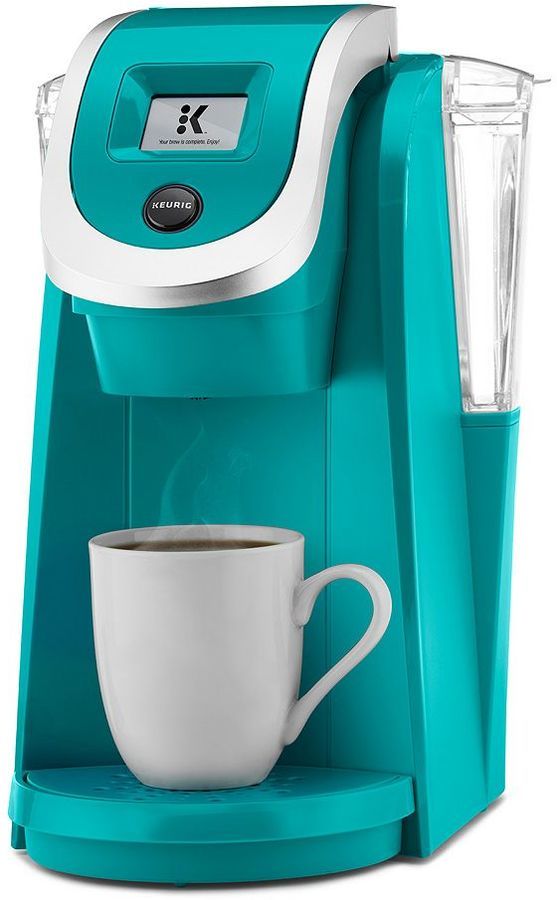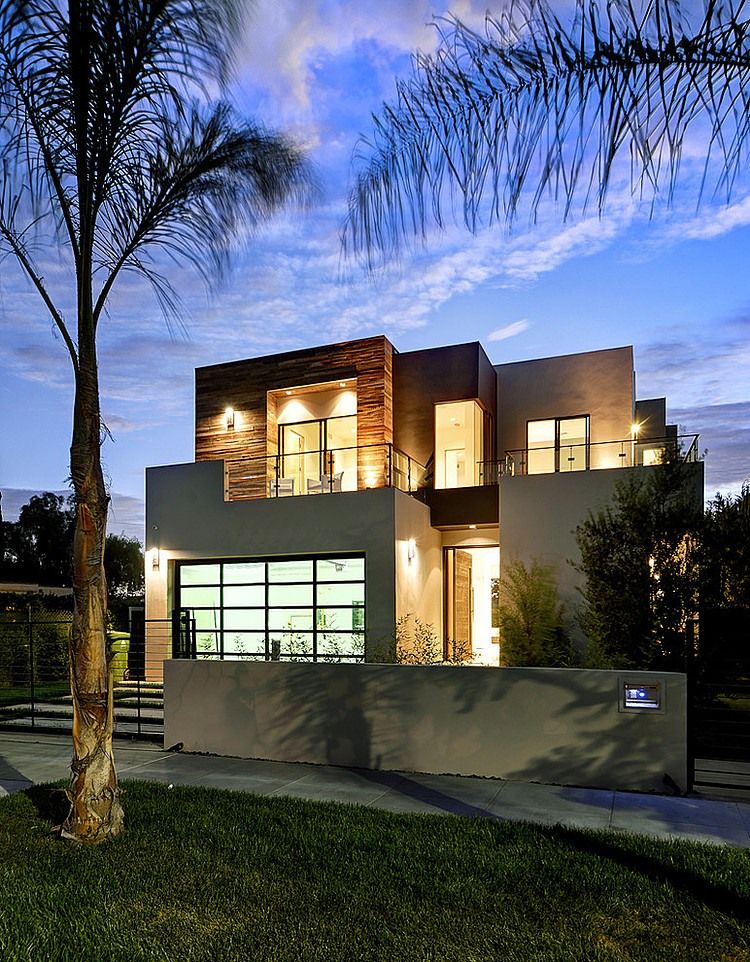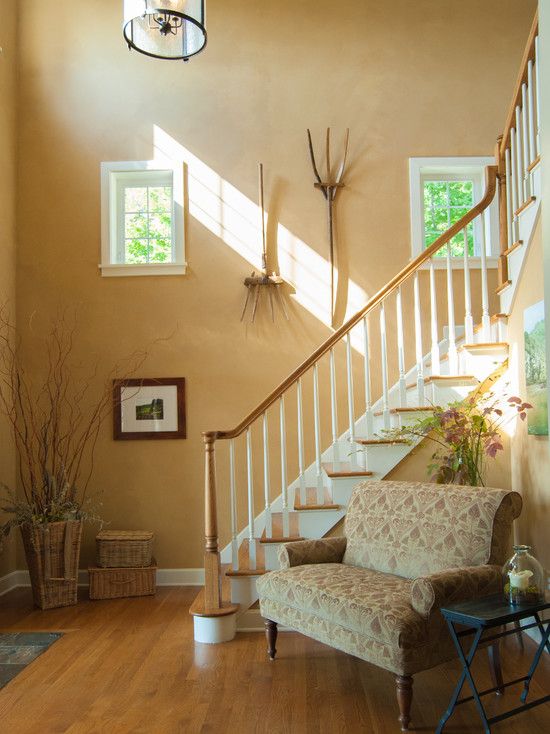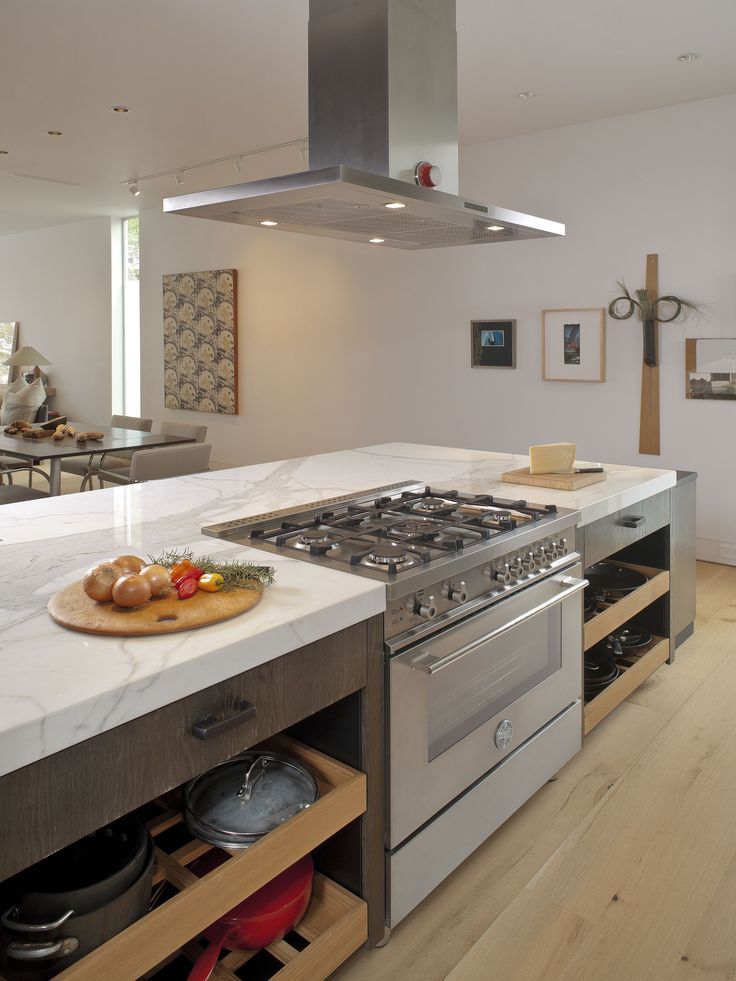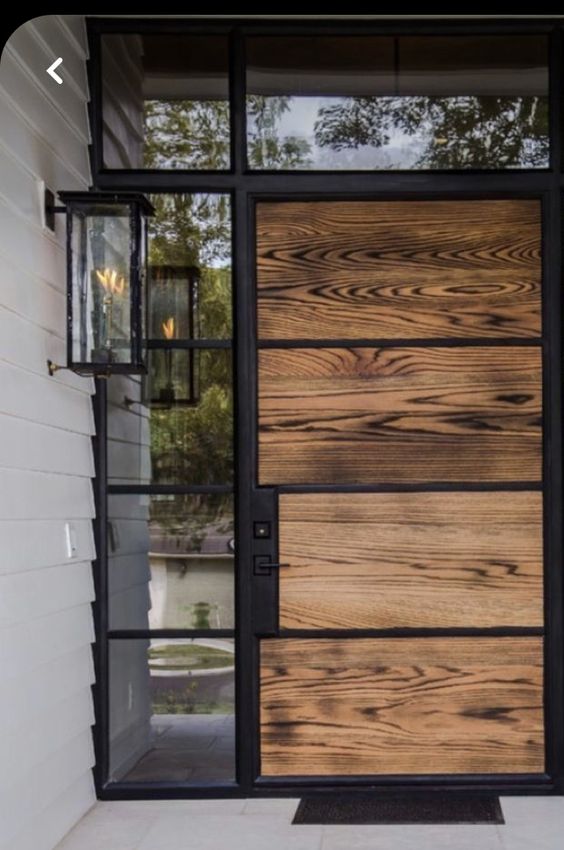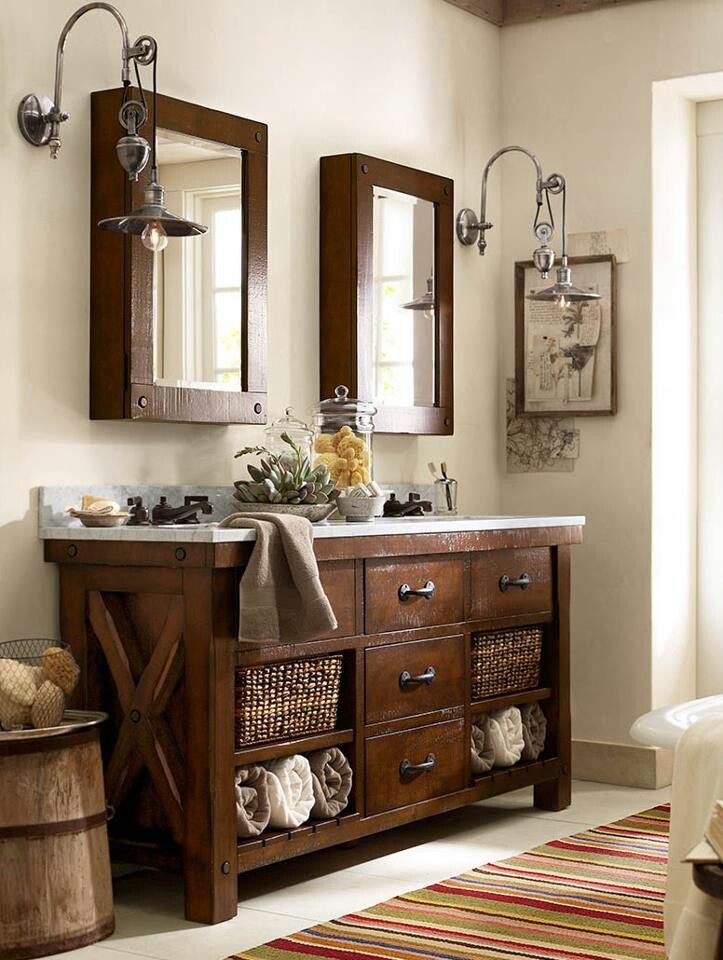Design home gym layout
Home Gym Floor Plan Examples
Space for Your Home Gym
One of the first steps is to determine how much space you can allocate to the gym.
- Minimal. Will it be in the corner of a bedroom? In other words, a minimal area.
- Small to Medium. Do you have a spare bedroom you could repurpose? With a typical bedroom size between 10 ft x10 ft (3m x 3 m) and 15 ft x15 ft (4.5m x 4.5 m), this is a good option for a basic home gym.
- Large. Do you have a larger available space, such as a garage, basement, or outdoor pool house? This size area gives you the most options and allows you to add equipment for several people to work out at the same time.
Check out our home gym floor plan examples to get an idea of what types of equipment can fit in each size room.
Exercise Goals
Next, think through your exercise goals to determine the essential items to place in your home gym. Here are just some of the possibilities.
Cardio. If your goal is to get your heart rate up, there are a lot of options. A simple jump rope requires a small area but provides a great cardio workout. With more space available, consider adding a mid-size unit like a stair machine to the layout. If the room size allows, you can add a larger piece of equipment such as a treadmill, elliptical, bike, or rowing machine.
Weight training. There are several ways to meet a weight training goal. A simple option is a kettlebell, a set of barbells, and ideally, a mirror to check your form. Adding a bench opens up the possibility for a lot more bench+barbell exercises. A more significant option with lots of flexibility is an integrated home gym machine. Another choice is a compact or full-size power rack, which allows you to lift heavier weights.
Yoga or stretching. If yoga is your goal, you'll want space for a yoga mat and accessories, perhaps resistance bands or a foam roller, or even a ballet barre.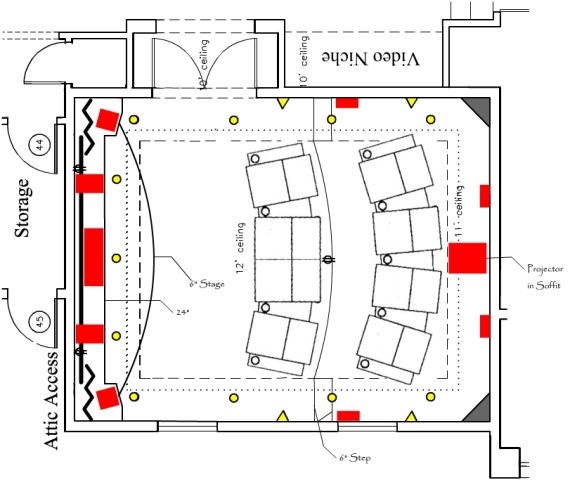
Balance and coordination. Maintaining and improving balance and coordination is important for seniors, athletes, and really, everyone. Consider adding some of these pieces of equipment to your home gym: a BOSU Balance Trainer, balance boards, balance balls.
Virtual classes or training. One of the latest trends is an interactive training device such as a Mirror home gym. This type of linked, subscription-based option allows you to take classes, connect with a trainer, and track your results. For a less expensive choice, a zoom class over a simple laptop is another possibility.
Home Gym Accessories
To complete your home gym, consider adding some useful accessories to the layout. For example, one or more simple wall-mounted mirrors in the room can help you review your form when weightlifting or doing yoga. With a TV or computer screen, you can catch up on your favorite show and meet your exercise goals simultaneously. Bluetooth speakers allow you to play your favorite pump-me-up or relax-me tunes while you exercise.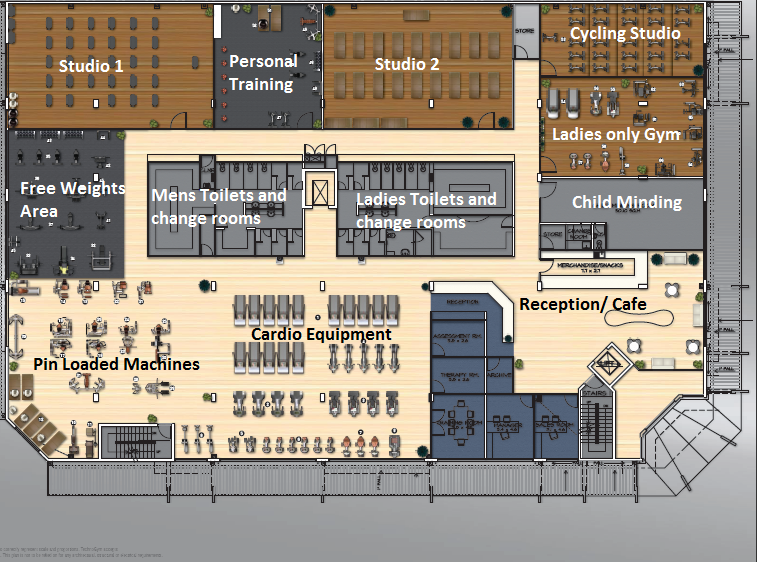 If the room doesn't have significant airflow from a window, consider adding a fan. A stack of towels with a hamper is a nice touch. Finally, think about the flooring in the room. With simple interlocking foam tiles, you can dampen the noise and add some cushioning while you work out.
If the room doesn't have significant airflow from a window, consider adding a fan. A stack of towels with a hamper is a nice touch. Finally, think about the flooring in the room. With simple interlocking foam tiles, you can dampen the noise and add some cushioning while you work out.
Are you ready to up your exercise game? Use these tips and sample home gym floor plans to create a workout space that you'll love and enjoy using.
Small Home Gym Layout: 8 Floor Plans From 100-500 Square Feet
When you’re building a home gym, it can be hard to visualize what can and can’t fit in your space. We hired an architect to create eight home gym floor plans to show you how you can customize a home gym to help you meet your goals.
In the article below, I’ll review:
- How much space you need for your gym equipment
- Ideas for building a home gym based on how large your room is
- Tips for organizing a small home gym
- What equipment you should buy right away and what can wait for the future
Small Home Gym Set Up: Understanding Your Floor Plans
Whether you have a small or a large room in which to build your home gym, you can make the space work for you.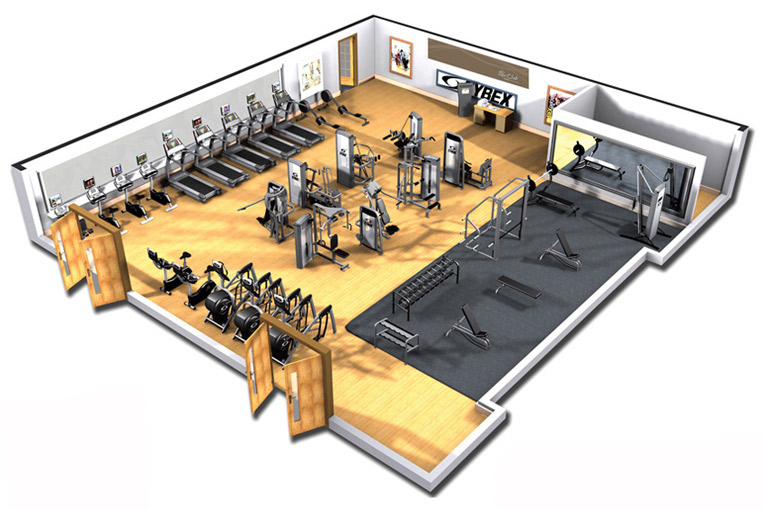 Depending on the size of your room, you may have to get creative with how you arrange your equipment and which exercises you perform, but it’s possible to create a functional workout space no matter how big your room is.
Depending on the size of your room, you may have to get creative with how you arrange your equipment and which exercises you perform, but it’s possible to create a functional workout space no matter how big your room is.
Before we get into the home gym floor plans our architect created, let’s review how much space is required for your equipment.
The chart below shows how much space you need for the most common pieces of home gym equipment. Each individual manufacturer’s specifications may vary slightly, but you can use this chart as a guide to help you measure out your home gym space.
| Power cage | At least 70 ft2 |
| Squat stand | 16 – 20 ft2 |
| Bench | 6 – 10 ft2 |
| Storage racks for free weights | 20 – 50 ft2 |
| Lifting platform | 32 ft2 or 64 ft2, depending on whether you get an Olympic lifting platform or a deadlift platform |
| Treadmill | 30 ft2, plus at least 3-5 feet of extra space in the back and on the sides |
| Spin bike | 7 – 10 ft2 |
| Plyo box | 5 ft2 |
| Multi-station gym | 50 – 200 ft2 |
| Single-station machines | At least 35 ft2 |
One important thing to keep in mind is that you’ll need room to comfortably squat, deadlift, and bench press without the bar hitting other equipment.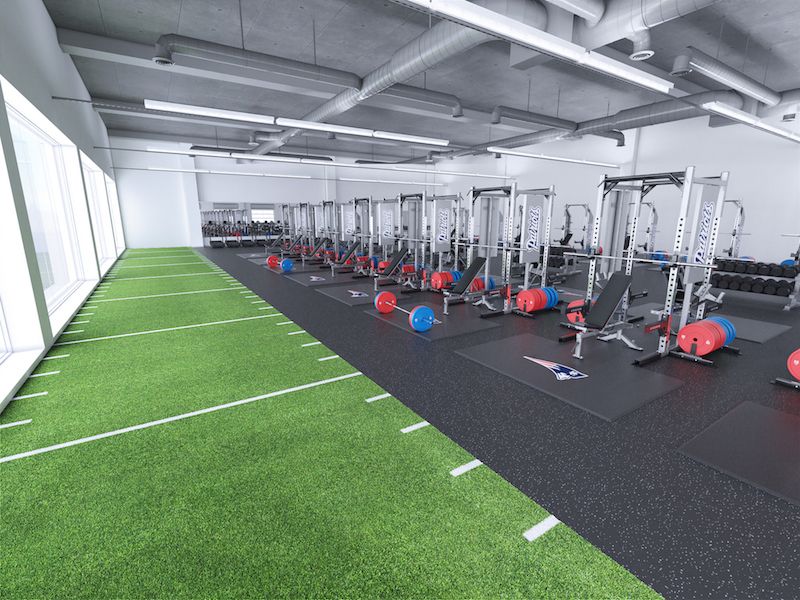 You’ll also need room on each side of your squat rack so you can easily load the bar.
You’ll also need room on each side of your squat rack so you can easily load the bar.
Most barbells are 7’ long and the sleeves extend about two feet past the edges of the squat rack. When taking measurements and deciding where you’ll put all of your equipment, make sure you leave a couple of feet of space on either side of your squat rack.
If you do snatches and clean and jerks, you’ll also want to make sure you have enough room to drop a barbell behind or in front of you without damaging something.
One of my favorite plyo boxes is the Rep Fitness 3 in 1 Soft Plyo Box (click for my full review)
500 Square Foot Home GymWhen you have a 500 square foot space to work with, you have a lot of options for building a home gym. There’s enough space for both strength and cardio equipment, and you’ll have room to work out with friends or family members as well.
In this large of a room, you can fit a squat rack or power cage, dumbbell and kettlebell storage racks, plates, a bench, a plyo box, several isolation machines, and a couple of different cardio machines while still having plenty of room to walk around and do other exercises on the floor.
Check out our 500 square foot home gym floor plan.
400 Square Foot Home GymA 400 square foot home gym is still a large enough space to fit a squat rack or power cage, storage racks for kettlebells and dumbbells, plates, a bench a plyo box, and different types of barbells like a deadlift bar or a trap bar.
This size gym is also large enough for multiple cardio machines as well as isolation machines like a cable station, leg press, or lat pulldown machine, and you’ll still have space to train with other people if you like to work out with your spouse or kids.
Check out our 400 square foot home gym floor plan.
300 Square Foot Home GymIn a 300 square foot home gym, you still have a lot of flexibility with which equipment you add. You have room for a power cage, dumbbell and kettlebell storage racks, a bench, a plyo box, and bodybuilding machines. Large cardio machines like treadmills and rowers will also fit, as will a lifting platform.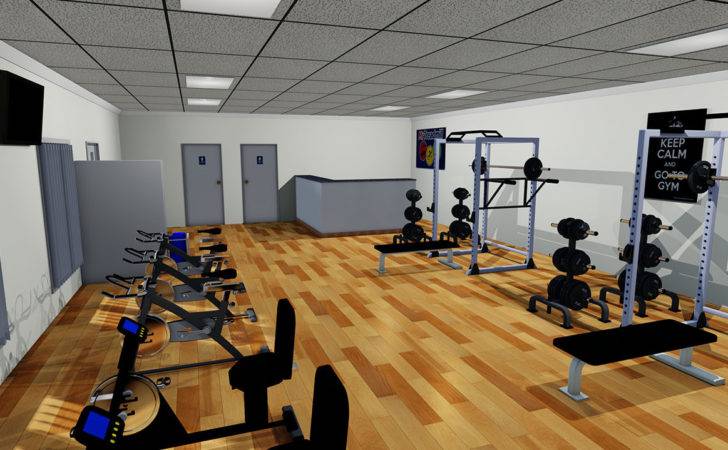
Check out our 300 square foot home gym floor plan.
250 Square Foot Home GymAt 250 square feet, you’re getting into a situation where you need to start making some sacrifices. You can still fit a lot of equipment, but you’ll have to be more selective and choose the machines and equipment that are most important to you.
You can fit a power cage in a 250 square foot home gym, but it will limit how many other machines you add if you also wanted a cardio machine or isolation machines. You could fit a multi-station machine, but depending on how large it is, you may not be able to fit a squat stand, power cage, or other single-station machines.
Check out our 250 square foot home gym floor plan.
200 Square Foot Home GymA 200 square foot home gym is still large enough for a power cage, but you may want to consider a squat stand instead so you have more room for other exercises.
Alternatively, you can get a wall-mounted foldable squat rack, many of which take up less than a foot when they’re fully extended.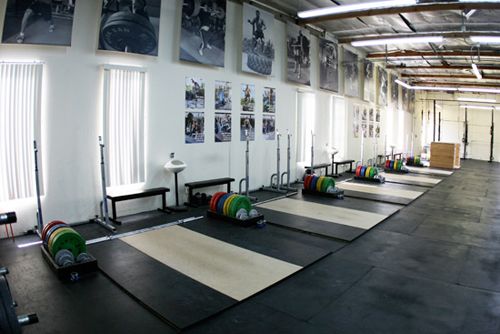 This will give you more floor space to do CrossFit WODs or HIIT workouts and will make the room feel less claustrophobic. If you go in this direction, you can also fit a treadmill or another cardio machine, or a couple of isolation machines.
This will give you more floor space to do CrossFit WODs or HIIT workouts and will make the room feel less claustrophobic. If you go in this direction, you can also fit a treadmill or another cardio machine, or a couple of isolation machines.
Check out our 200 square foot home gym floor plan.
150 Square Foot Home GymAs we start getting into spaces less than 200 square feet, you’ll need to really narrow down your equipment list and stick to a few essential pieces.
A lot of large isolation machines won’t fit into a 150 square foot home gym, so you’ll have to use free weights for the bulk of your resistance training. And while you could fit a treadmill or a rower in addition to a squat rack, the room will feel cramped.
You’ll also want to consider a squat stand instead of a power cage to save room and look for things like adjustable dumbbells and wall-mounted storage racks to free up some space.
Check out our 150 square foot home gym floor plan.
In a 120 square foot home gym, you’ll have room for a squat stand, bench, dumbbells, and potentially a cardio machine. A treadmill could fit, but you may be better off with a spin bike or a small elliptical to save some space. For CrossFitters, a rower or Echo bike won’t fit into a 120 square foot home gym either, since they could get in your way during a WOD.
But if endurance-based goals are more important to you, you can get still get a treadmill and leave out a squat rack, using dumbbells for any strength training you want to do.
Check out our 120 square foot home gym floor plan.
100 Square Foot Home GymA room that’s only 100 square feet is small for a home gym, but it’s still possible to add a few pieces of essential equipment. Since you won’t be able to fit isolation machines, your strength training will need to be done with free weights. You definitely won’t be able to fit a power cage and have room for other exercises, so you’ll have to get a squat stand.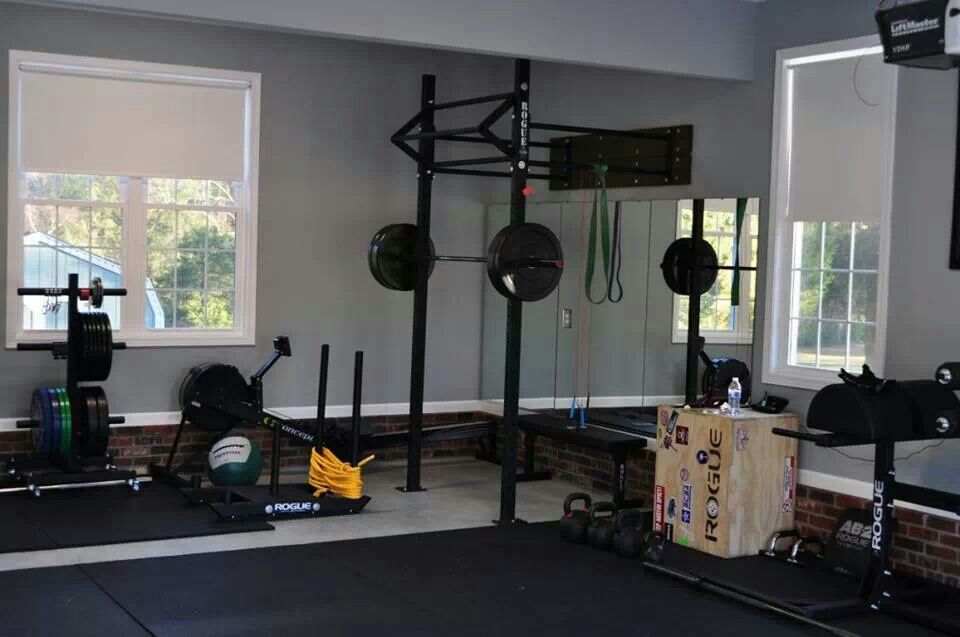
If you want a piece of cardio equipment, your best bet is to get a spin bike, which has a smaller footprint than a treadmill or elliptical. Otherwise, you’ll need to forego a squat rack altogether and instead do all of your strength training with dumbbells or kettlebells.
Check out our 100 square foot home gym floor plan.
8 Tips For Organizing Your Small Home Gym
My 8 tips for organizing a small home gym are:
- Decide where and how you want to arrange your equipment
- Measure carefully
- Consider other belongings that you’ll be storing in your gym space
- Buy your equipment in stages
- Look for space-saving solutions that free up some room
- Protect your floors
- Double-check the construction of your walls when installing wall-mounted squat racks or pullup bars
- Leave room for heaters and fans
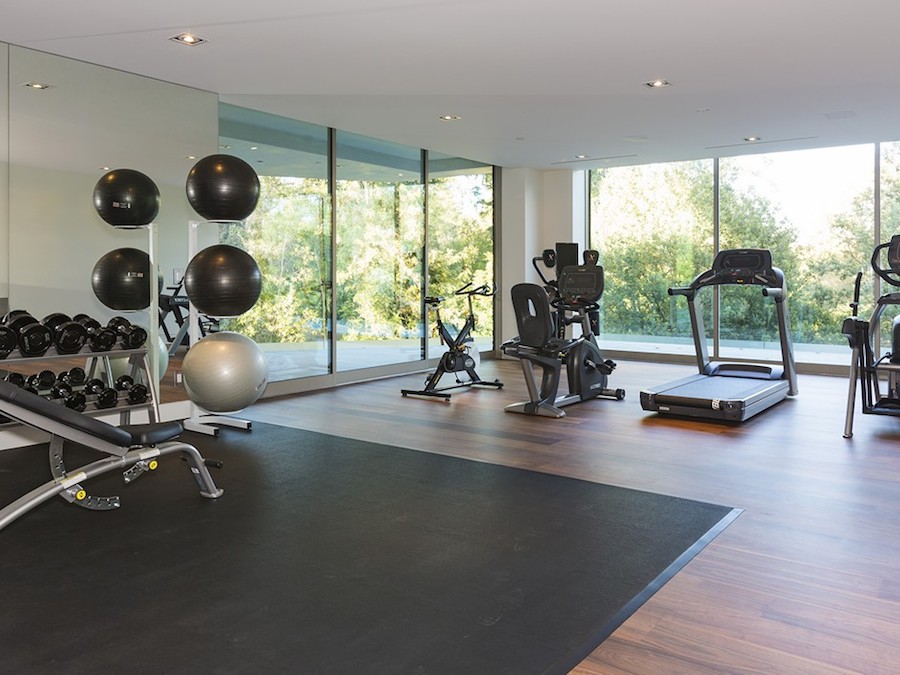 Decide Where and How You Want To Arrange Your Equipment
Decide Where and How You Want To Arrange Your EquipmentMost people build home gyms in garages or basements, but you can put equipment in a living room, dining room, or bedroom if you don’t mind having gym equipment in your living spaces. You can also build a home gym in an attic, as long as the ceilings are high enough and the floors are sturdy.
Once you’ve figured out the most optimal place in your home for a gym, consider how you want to arrange your equipment.
CrossFitters, for example, will want to make sure they have enough room to put a barbell on the floor for WODs while still being able to do other movements. If your WOD times are important to you, you’ll also want to make sure you can put everything you need for a WOD in close proximity to each other so you don’t waste time transitioning from one spot to another.
For everyone else, think about which equipment you’ll use the most often and put those pieces as close to each other as possible.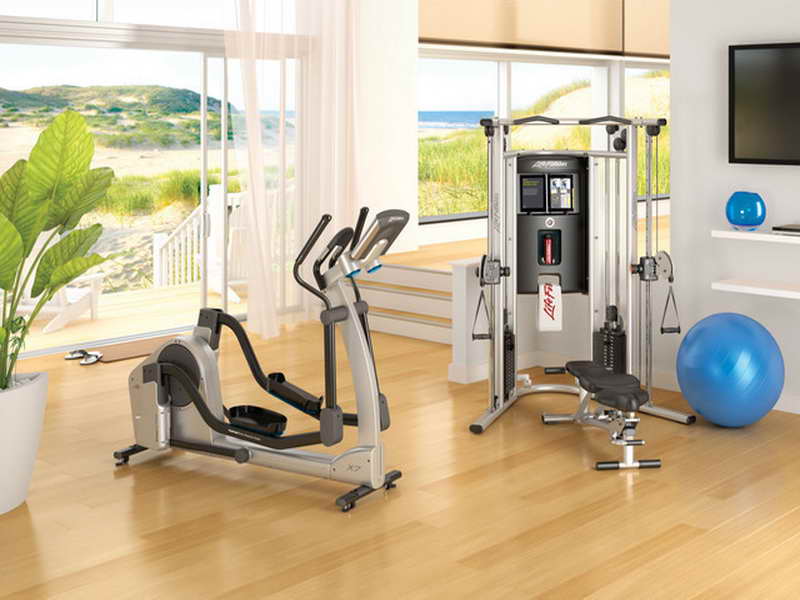 This isn’t as much of a concern in a small room, but if you have a large space, this will allow you to keep your most-used equipment in one central area.
This isn’t as much of a concern in a small room, but if you have a large space, this will allow you to keep your most-used equipment in one central area.
When you have a larger space to work with, it’s usually not a big deal if you make a mistake when measuring since you have more flexibility in where you place your equipment. But when you have a small home gym, it’s important to double-check your measurements so you don’t wind up with equipment that’s too large for your space.
Most gym equipment suppliers list the product dimensions on their websites. Before you purchase anything, measure the area where you want to put each piece of equipment to make sure everything will fit. You may even want to make boxes with tape on the floor where you envision everything going so you can visualize how it will all fit.
3. Consider Other Belongings That You’ll Be Storing in Your Gym SpaceUnless you have a room that will be used exclusively for your home gym, you’ll probably have other belongings that you’ll need to work around.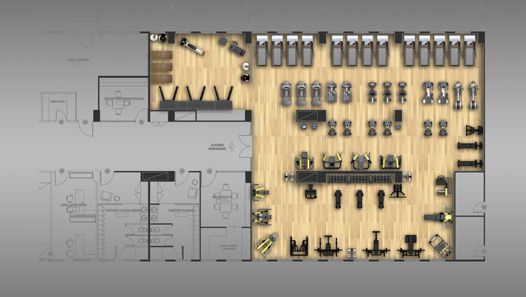 You may need to rearrange some furniture or change how you utilize the space.
You may need to rearrange some furniture or change how you utilize the space.
For example, if you’re building your home gym in your garage, can you still park your car in it, or will you have to start parking on the street or in your driveway?
You should also make sure that you don’t leave important items too close to where you’ll be working out. If you have to drop your weights from overhead or bail a lift by dropping your barbell on the floor, you don’t want it to roll away from you and damage your other belongings.
4. Buy Your Equipment in StagesBuying your gym equipment in phases will not only help you budget your expenses but will also allow you to visualize how your gym will come together as you slowly add to it.
For example, things like plates and dumbbells can be bought in stages. You can purchase weights based on where your strength is at right now, and then add more in the future as you get stronger and you replenish your budget.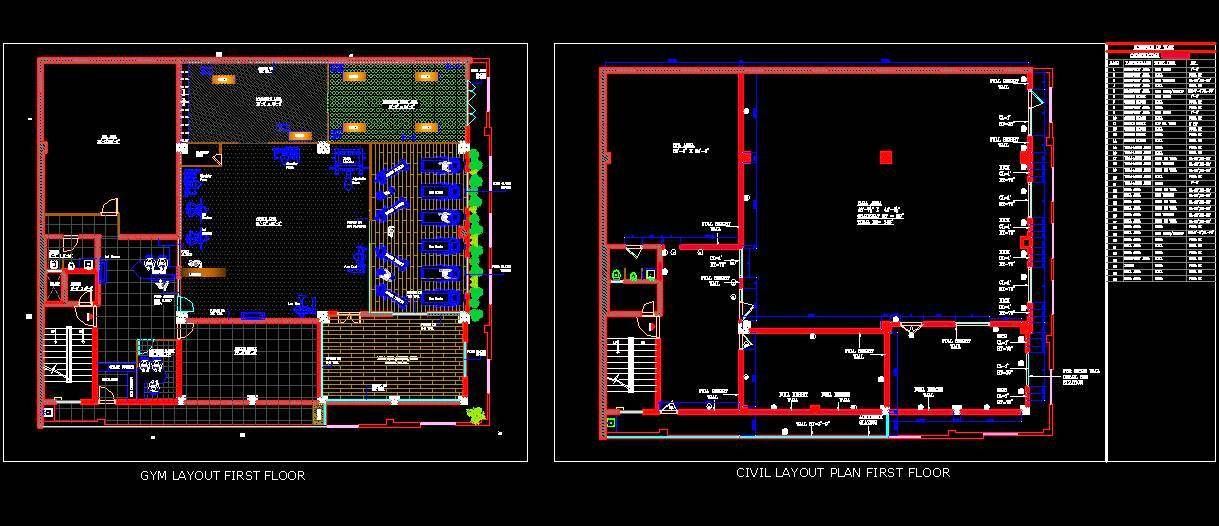
If your home gym area is small, you’ll need to find ways to maximize every inch of space so you can train comfortably.
Power cages are ideal when you’re lifting heavy weights because of the safety features they have, but if you don’t have a lot of room, you can look for a squat stand instead. You can also look for a collapsible squat rack that you can fold up against the wall when you’re done training.
As well, you can get a set of adjustable dumbbells instead of multiple pairs of dumbbells or a spin bike instead of a treadmill for cardio workouts. You can also get wall-mounted storage racks for your plates so you’re not taking up precious floor space with a plate storage tree.
6. Protect Your FloorsNo matter where you put your home gym, you should make sure your floors can support your activity. Even cement floors in garages or basements can crack when weights are repeatedly dropped on them.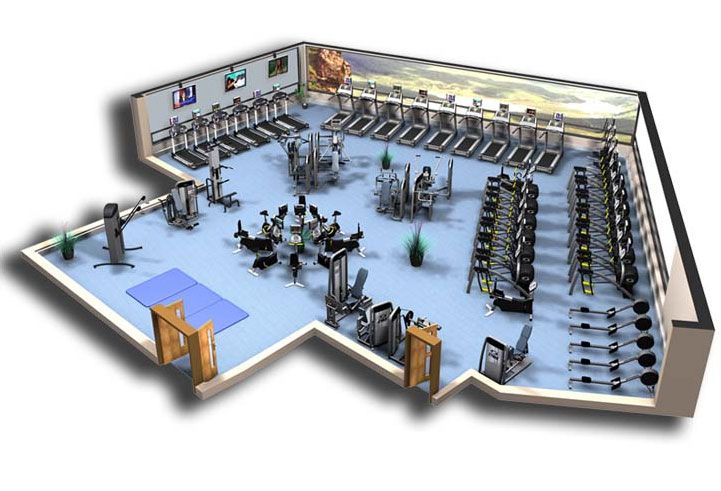
The best way to protect your floors is to build or purchase a lifting platform. Lifting platforms are made with a combination of plywood and rubber tiles and are sometimes surrounded by a metal frame. They absorb the shock from dropped weights and also help reduce noise, which is important to consider if you live with other people.
If you can’t buy or build a platform for whatever reason, you can get a pair of crash pads that also work to absorb shock and reduce noise. An added bonus of crash pads is that they’re easier to move around, so you can put them off to the side when you don’t need them.
Even if you don’t lift heavy weights, you should still get an exercise mat, rubber tiles, or horse stall mats to cover your floors. They’ll give you a softer surface to work out on, so if you do a lot of HIIT or jumping movements, you’ll put less stress on your ankles, knees, and calves.
One last thing to consider is whether or not you want to bolt your squat rack to the floor. If you do, you’ll need to make sure you can drill through any protective floor coverings. Otherwise, if you’re concerned about your squat rack wobbling, you can put heavy sandbags on it to keep it stable.
If you do, you’ll need to make sure you can drill through any protective floor coverings. Otherwise, if you’re concerned about your squat rack wobbling, you can put heavy sandbags on it to keep it stable.
If you’re planning on getting wall-mounted squat racks or pullup bars, you should make sure your walls can handle the weight. A carpenter or general contractor can inspect your walls for you if you want an expert opinion.
Many squat rack manufacturers recommend the use of stringers when bolting racks to your walls. Stringers are wood or metal supports that add extra stability to anything that’s mounted to your wall. Instead of screwing nails directly into concrete or masonry, you screw them into the stringers, which allows for a more secure installation.
8. Leave Room for Heaters and FansIf you work out in a garage, basement, or attic that’s not well-insulated, you’ll want something to help circulate air in the summer and warm up the space in the winter.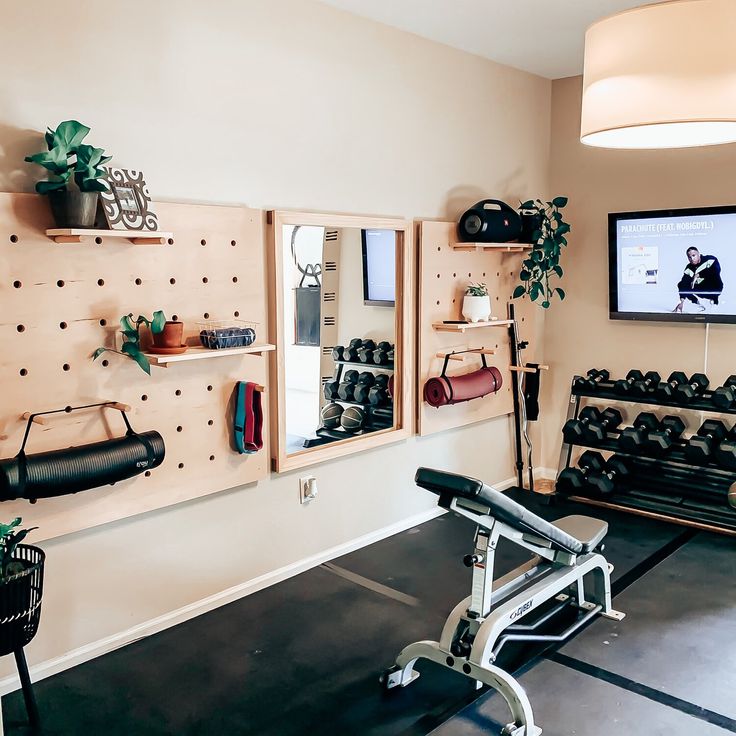
Fans and heaters don’t take up too much room, but you should still make sure you have enough space to fit them in your home gym so you can keep the temperature comfortable while you train.
Related Article: 20 Home Fitness Equipment Brands (That We Trust)
Equipment For Small Home Gym Set-Ups
As I mentioned earlier, when you start building your home gym, you don’t have to buy everything right away. It’s best to focus on a few essentials at the very beginning and add to it later on when you get a better feel for how everything will come together.
Of course, you have to consider your budget as well. Although you’ll save money in the long run by not paying for a gym membership, building a home gym will be a bit costly upfront. Buying equipment in phases gives you the opportunity to save money in between each large purchase rather than being stuck with a large expense at one time.
Must-Have Pieces of Equipment for Small Home GymsWhat you may consider a must-have for your home gym will depend on your goals, but for the most part, most home gyms will need at least the following:
- A squat stand
- A barbell
- Plates
- Dumbbells
- A bench
Bodybuilders and individuals who work out for general health purposes may want to start out with different pieces of isolation equipment.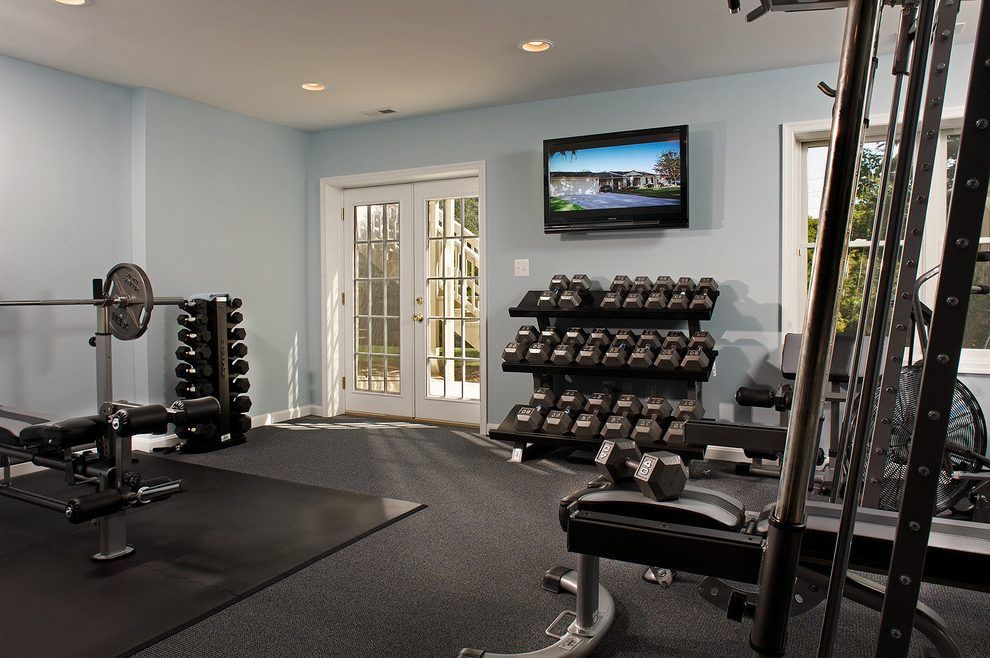 For example, a bodybuilder may consider a cable station a must-have while a general fitness enthusiast may consider a treadmill a necessity.
For example, a bodybuilder may consider a cable station a must-have while a general fitness enthusiast may consider a treadmill a necessity.
There are also a few smaller pieces of equipment I consider must-haves, but because they don’t take up much space, you won’t have to worry about where to store them. These items include:
- A jump rope
- Resistance bands
I would also recommend that most home gym users get one or two kettlebells, but again, it depends on your goals. If you don’t need or want them, you’d be better off getting more dumbbells or using the space for something else.
Check out 12 Types of Dumbbells Explained (Differences, Pros, Cons)
Small Home Gym Equipment to Buy in the FutureWhen you have the essential pieces of equipment I listed above, you can do a good amount of strength and cardio training. For that reason, there are some things that you don’t need to buy right away, including:
- A plyo box
- Different types of bars, such as a trap bar, deadlift bar, or EZ curl bar
- Jerk blocks, if you’re an Olympic weightlifter
- Medicine balls
- Isolation machines
I put isolation machines on this list only because you probably won’t want to buy multiple machines at once since they can be pricey. These are definitely pieces of equipment that you can purchase over time if you’re concerned about your budget.
These are definitely pieces of equipment that you can purchase over time if you’re concerned about your budget.
Other items on this list may not be necessary to you at all, so it’s important to consider both your current and future training goals before you start buying any equipment.
Frequently Asked Questions:
What Is A Good Size For A Home Gym?A good size for a home gym is about 150-250 square feet. This gives you enough room for both strength and cardio equipment. But you can build a home gym even if you don’t have that much space available. You just have to be selective about which equipment you buy.
How Small Can A Home Gym Be?You can build a home gym with as little as 50-60 square feet, but at that size, you’ll pretty much only have room for a bench and some dumbbells or a treadmill. For a home gym that includes a squat rack, a barbell, a bench, and plates, you should have at least 100 square feet. This will give you enough room to set up your equipment and still be able to walk around and lift comfortably.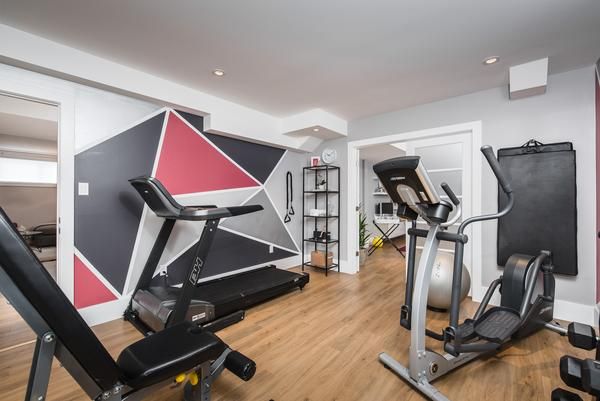
One of my favorite benches is the Rep Fitness Ab 3100 (click for my full review)
What Is The Best Height For A Small Home Gym?The best ceiling height for a small home gym will depend on several factors, including how tall your equipment is, how tall you are, and whether or not you’ll be doing a lot of overhead pressing and pullups. In most cases, a 9’ ceiling height is ideal. With ceilings of this height, you can fit most power cages, and most people can do pullups or overhead presses without hitting the ceiling.
If your ceiling is lower than 9’, you can still make a home gym work. You may not be able to fit a power cage, but you can get a squat stand instead, many of which stand at just 6’ tall. And you may not be able to do certain movements, but you can swap them out for others. For example, you can do different row variations instead of pullups or find substitutions for overhead presses.
If you’re tall and have low ceilings, you’ll also want to make sure you have enough clearance between the plates on the bar and the ceiling when you do overhead lifts. This is especially important if you train with bumper plates. They extend about eight inches over the bar, so you may hit the ceiling when you lift the bar overhead, especially if you have long arms.
This is especially important if you train with bumper plates. They extend about eight inches over the bar, so you may hit the ceiling when you lift the bar overhead, especially if you have long arms.
One last thing to consider is whether or not you’ll be lifting on a raised platform. If so, you’ll need to account for a couple of inches of added height when trying to figure out how much room you have between the bar and the ceiling when you’re holding a barbell overhead.
Other Home Gym Resources
- How To Protect Your Floor From Weights (6 Ways)
- Putting A Squat Rack In An Apartment (Complete Guide)
- How Do I Warm-Up My Garage Gym (10 Tips That Actually Work)
- 15 Things To Consider When Buying A Home Gym Treadmill
- 9 Best Speakers For Garage Gym (Tried & Tested)
- 7 Best Dumbbells That You Can Drop Without Damaging Them
- Best Gym Clocks & Timers (Bought & Tested 7 Different Types)
- Best Cable Attachments (10 Options For Home Gyms)
- How To Store Dumbbells At Home (My Top 4 Favorite Ways)
Final Thoughts
Building a home gym has a lot of benefits, from saving money on a gym membership, being able to work out on your own time, and not having to wait for equipment to become available.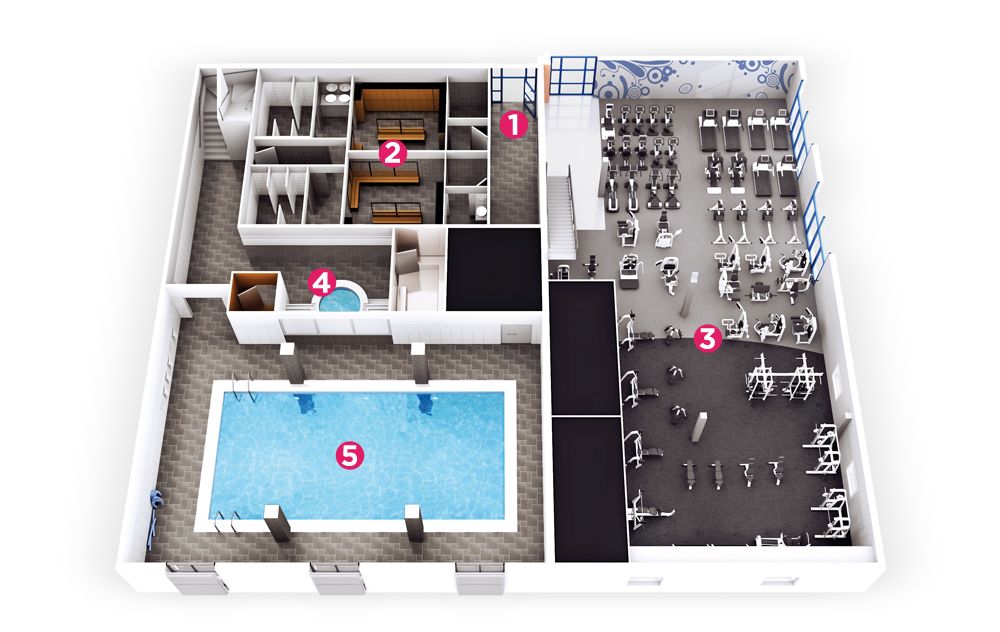
Fortunately, you can build a home gym in a room as small as 100 square feet. The equipment you buy depends on exactly how much space you have and what your training goals are, but the floor plans and tips I shared above should give you some ideas on how you can structure your own home gym.
About The Author
Amanda DvorakAmanda is a writer and editor in the fitness and nutrition industries. Growing up in a family that loved sports, she learned the importance of staying active from a young age. She started CrossFit in 2015, which led to her interest in powerlifting and weightlifting. She’s passionate about helping women overcome their fear of lifting weights and teaching them how to fuel their bodies properly. When she’s not training in her garage gym or working, you can find her drinking coffee, walking her dog, or indulging in one too many pieces of chocolate.
Home Gyms - 55 Best Home Gym Design Ideas
Fili City Residential Complex
Andrey Rudoy
Original Design Example: Neoclassical (Modern Classic) Home Gym with White Walls, Medium Parquet Floors and Brown Floors
Belsize Village Apartment
NW3 Interiors Ltd
Pictured: neoclassical (modern classic) home gym with gray walls, medium hardwood floors and brown floors
Extreme Renovation
Young & Borlik Architects, inc.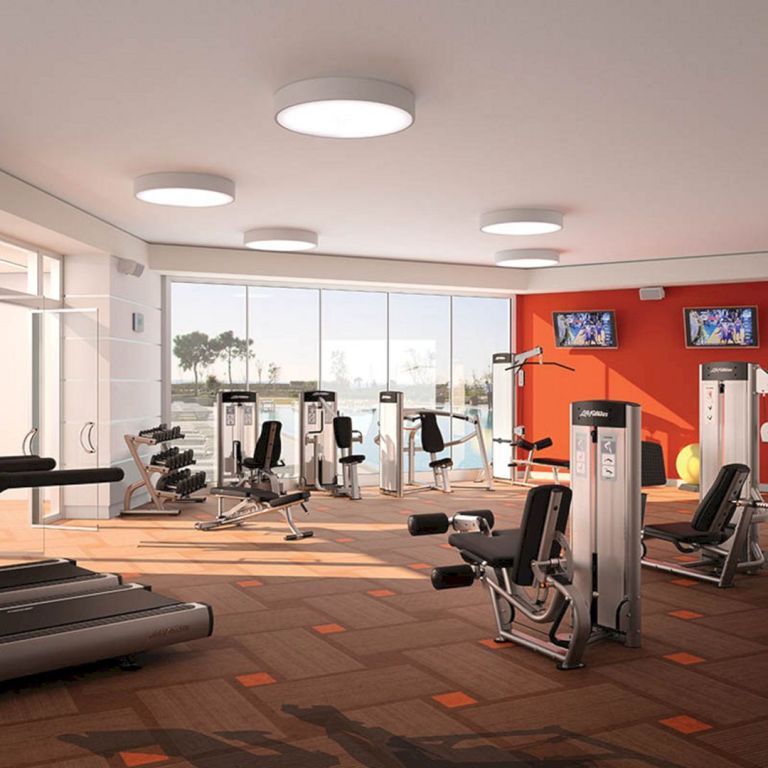
Walls are removed and a small bedroom is converted into an exercise room with mirror walls, ballet bar, yoga space and plenty of room for fitness equipment.
Big Sky Yoga Studio
grouparchitect
Photo of a small modern style yoga studio with white walls, cork flooring and brown floors
Heber, UT
Timber Creek Construction
Inspiration for home comfort: a huge modern-style versatile home gym with white walls, light parquet floors and beige floors
Residential Squash Court and Pool House
Wyant Architecture court allow it to remain connected to the outdoors. Felt ceiling tiles reduce reverberation and echo. Photo: Jeffrey Totaro
2018 Parade of Homes | Daphne
User
Lower level exercise room - use as a craft room or another secondary bedroom.
Photo of a medium-sized contemporary yoga studio with blue walls, laminate flooring and beige flooring
Smiens Lower Level
Rebecca Ryan Design
Inspiration for home comfort: versatile home gym in modern style with brown walls and subfloor
Tower Lakes Basement Renovation
Advance Design Studio, Ltd.
Karen and Chad of Tower Lakes, IL were tired of their unfinished basement functioning as nothing more than a storage area and depressing gym. They wanted to increase the livable square footage of their home with a cohesive finished basement design, while incorporating space for the kids and adults to hang out. “We wanted to make sure that upon renovating the basement, that we can have a place where we can spend time and watch movies, but also entertain and showcase the wine collection that we have,” Karen said. After a long search comparing many different remodeling companies, Karen and Chad found Advance Design Studio. They were drawn towards the unique “Common Sense Remodeling” process that simplifies the renovation experience into predictable steps focused on customer satisfaction. “There are so many other design/build companies, who may not have transparency, or a focused process in mind and I think that is what separated Advance Design Studio from the rest,” Karen said. Karen loved how designer Claudia Pop was able to take very high-level concepts, “non-negotiable items” and implement them in the initial 3D drawings.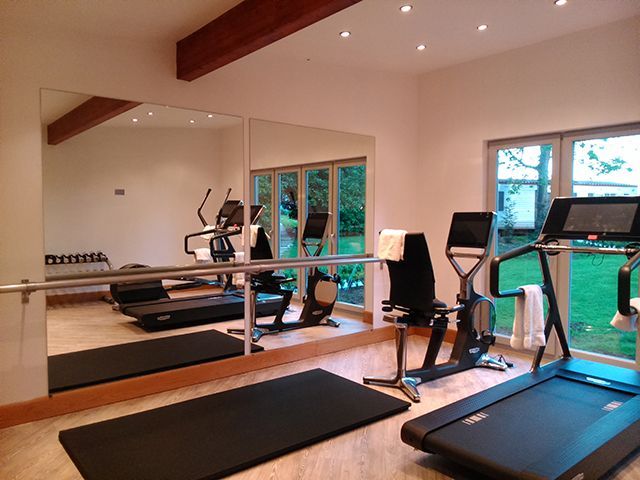 Claudia and Project Manager DJ Yurik kept the couple in constant communication through the project. “Claudia was very receptive to the ideas we had, but she was also very good at infusing her own points and thoughts, she was very responsive, and we had an open line of communication,” Karen said. A very important part of the basement renovation for the couple was the home gym and sauna. The “high-end hotel” look and feel of the openly blended work out area is both highly functional and beautiful to look at. The home sauna gives them a place to relax after a long day of work or a tough workout. “The gym was a very important feature for us,” Karen said. “And I think (Advance Design) did a very great job in not only making the gym a functional area, but also an aesthetic point in our basement.” An extremely unique wow-factor in this basement is the walk in glass wine cellar that elegantly displays Karen and Chad’s extensive wine collection. Immediate access to the stunning wet bar accompanies the wine cellar to make this basement a popular spot for friends and family.
Claudia and Project Manager DJ Yurik kept the couple in constant communication through the project. “Claudia was very receptive to the ideas we had, but she was also very good at infusing her own points and thoughts, she was very responsive, and we had an open line of communication,” Karen said. A very important part of the basement renovation for the couple was the home gym and sauna. The “high-end hotel” look and feel of the openly blended work out area is both highly functional and beautiful to look at. The home sauna gives them a place to relax after a long day of work or a tough workout. “The gym was a very important feature for us,” Karen said. “And I think (Advance Design) did a very great job in not only making the gym a functional area, but also an aesthetic point in our basement.” An extremely unique wow-factor in this basement is the walk in glass wine cellar that elegantly displays Karen and Chad’s extensive wine collection. Immediate access to the stunning wet bar accompanies the wine cellar to make this basement a popular spot for friends and family.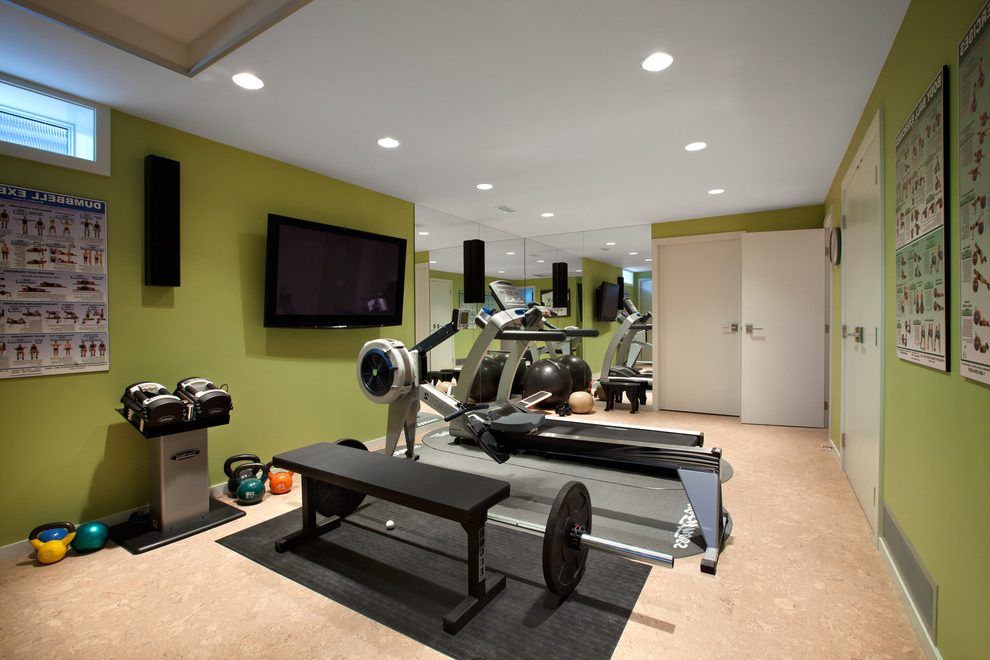 The custom-built wine bar brings together two natural elements; Calacatta Vicenza Quartz and thick distressed Black Walnut. Sophisticated yet warm Graphite Dura Supreme cabinetry provides contrast to the soft beige walls and the Calacatta Gold backsplash. An undermount sink across from the bar in a matching Calacatta Vicenza Quartz countertop adds functionality and convenience to the bar, while identical distressed walnut floating shelves add an interesting design element and increased storage. Rich true brown Rustic Oak hardwood floors soften and warm the space drawing all the areas together. Across from the bar is a comfortable living area perfect for the family to sit down at a watch a movie. A full bath completes this finished basement with a spacious walk-in shower, Cocoa Brown Dura Supreme vanity with Calacatta Vicenza Quartz countertop, a crisp white sink and a stainless-steel Voss faucet. Advance Design's Common Sense process gives clients the opportunity to walk through the basement renovation process one step at a time, in a completely predictable and controlled environment.
The custom-built wine bar brings together two natural elements; Calacatta Vicenza Quartz and thick distressed Black Walnut. Sophisticated yet warm Graphite Dura Supreme cabinetry provides contrast to the soft beige walls and the Calacatta Gold backsplash. An undermount sink across from the bar in a matching Calacatta Vicenza Quartz countertop adds functionality and convenience to the bar, while identical distressed walnut floating shelves add an interesting design element and increased storage. Rich true brown Rustic Oak hardwood floors soften and warm the space drawing all the areas together. Across from the bar is a comfortable living area perfect for the family to sit down at a watch a movie. A full bath completes this finished basement with a spacious walk-in shower, Cocoa Brown Dura Supreme vanity with Calacatta Vicenza Quartz countertop, a crisp white sink and a stainless-steel Voss faucet. Advance Design's Common Sense process gives clients the opportunity to walk through the basement renovation process one step at a time, in a completely predictable and controlled environment. “Everything was designed and built exactly how we envisioned it, and we are really enjoying it to it’s full potential,” Karen said. Constantly striving for customer satisfaction, Advance Design’s success is heavily reliant upon happy clients referring to their friends and family. “We definitely will and have recommended Advance Design Studio to friends who are looking to embark on a remodeling project small or large,” Karen exclaimed at the completion of her project.
“Everything was designed and built exactly how we envisioned it, and we are really enjoying it to it’s full potential,” Karen said. Constantly striving for customer satisfaction, Advance Design’s success is heavily reliant upon happy clients referring to their friends and family. “We definitely will and have recommended Advance Design Studio to friends who are looking to embark on a remodeling project small or large,” Karen exclaimed at the completion of her project.
7
Ranger's Ridge
Giulietti Schouten Weber Architects
Photo: David Papazian
Design idea for a mid-size versatile home gym in modern style with white walls, carpeting and gray floors
matching interior styles and design options
To maintain excellent physical shape, it is not necessary to buy a subscription to the club. You can set up a gym at home. Designers will tell you how to create indoor conditions for comfortable and productive activities.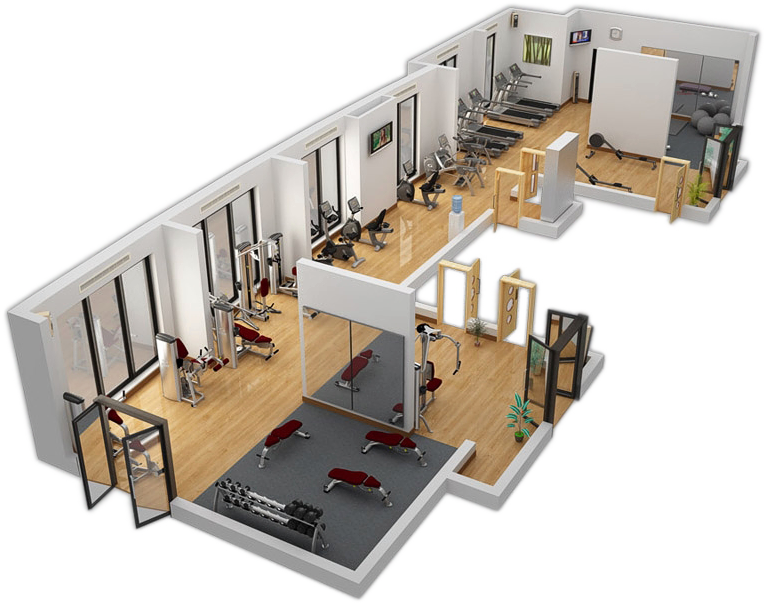
Contents
- 1. Ideal home gym space
- 2. Home gym design: finishing options
- 2.1. Colors for a harmonious interior
- 2.2. Wall and floor finishing
- 3. How to equip a gym in an apartment and a house: fitness equipment, furniture and accessories
- 3.1. Gym equipment
- 3.2. Furniture
- 3.3. Functional accessories and technology
- 4. Sports hall lighting in the house and apartment
- 5. Decor in the interior of the gym
- 6. Interior style for gym design
- 6.1. Eclectic
- 6.2. Chateau
- 6.3. Ecostyle
- 6.4. Classic
- 6.5. Modern
Ideal home gym space
You don't have to have a lot of sports equipment and equipment in your room. For homework, two or three shells are enough. However, the equipment must be arranged so that you can easily move around the room and freely perform the exercises. Therefore, designers recommend using a room of at least 8 square meters for a gym.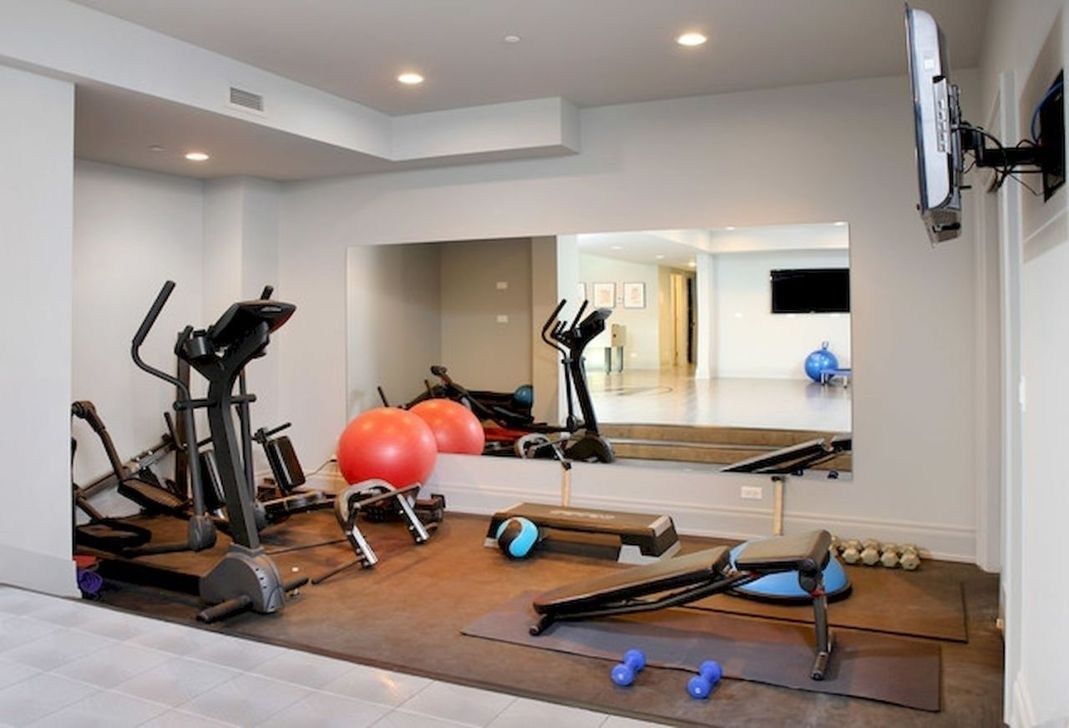
Two more selection criteria: high levels of natural light and good ventilation. Glazed verandas and attics in private houses fully comply with these requirements. If you equip a gym in such premises, it will take less effort to work out the technical nuances of the project. In the apartment, you can use any room that is suitable in size.
home gym design
Home Gym Design: Finishes
A house or apartment with a gym is the perfect solution for people who want to take care of their health and fitness. The goal of designers is to make the room feel comfortable. A comfortable environment will be conducive to classes and achieve maximum results. The first steps in creating a project are the choice of colors and finishing materials.
Colors for a harmonious interior
Designers select colors for decoration based on the psychology of colors. Discreet shades are considered the best, which contribute to concentration in training, but do not overexcite. Therefore, bright flashy tones are extremely rare in design. Experts prefer colors from the pastel spectrum - they successfully act as a base.
Therefore, bright flashy tones are extremely rare in design. Experts prefer colors from the pastel spectrum - they successfully act as a base.
Cool blues and grays can be used as accent tones. The presence of black is not excluded. In moderation, it also gives motivation and invigorates.
A few more suitable shades for decoration: light pink, peach, green, brown. To achieve a harmonious interior, it is worth combining no more than three colors.
Wall and floor decoration
To decorate the walls of a room in a modern style, you can use brick, decorative plaster, cork panels. Wallpaper works too. It is better to choose the most concise design without catchy patterns. Against such a background, thematic decorative elements will look great.
Home gym flooring must be soundproof. Designers prefer materials with increased strength, resistance to mechanical stress. Another important requirement is an anti-slip surface.
Stone floors are not the best choice for a gym.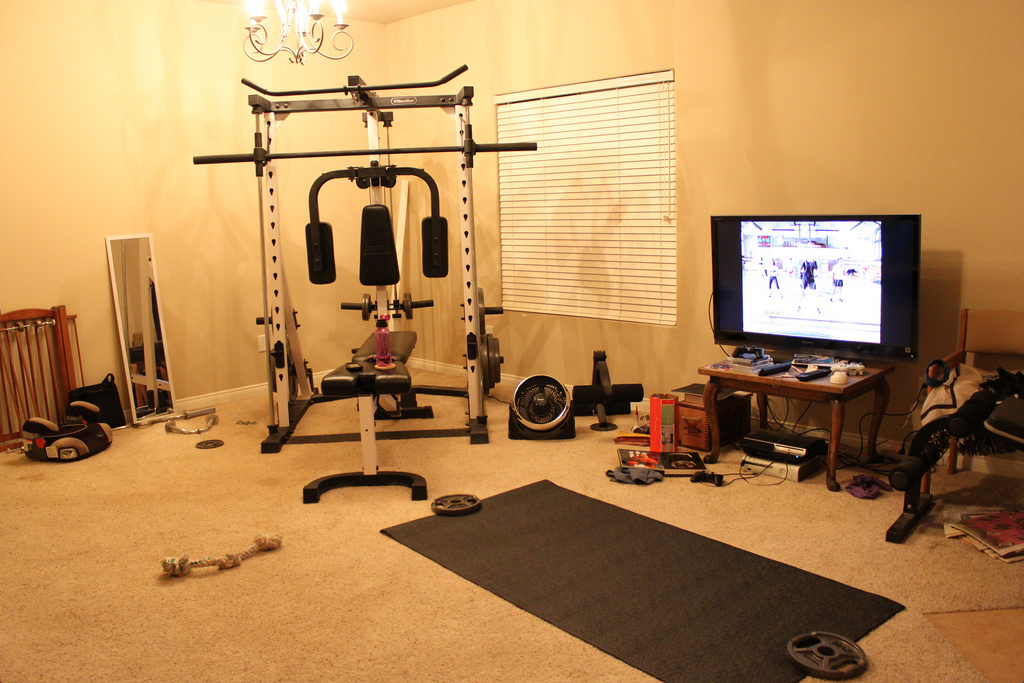 Parquet is also not very appropriate due to the high humidity in the room. Optimal solutions: carpet, rubber or cork flooring.
Parquet is also not very appropriate due to the high humidity in the room. Optimal solutions: carpet, rubber or cork flooring.
An example of wall and floor decoration in a gym
How to equip a gym in an apartment and a house: fitness equipment, furniture and accessories
The main thing in a gym is its functional content. Work on interior design does not end with the purchase of exercise equipment. It is also necessary to choose related accessories and stylish furniture. Let's talk about the nuances of choice.
Gym equipment
The number of equipment depends on the preferences of the owners and the dimensions of the room. You can get by with the most necessary and place one or two shells. For example, a treadmill, wall bars, horizontal bar.
Massive weight machines should only be placed in spacious rooms. The equipment is quite heavy, so it is important to pre-evaluate the load on the flooring.
Now there is a lot of stylish equipment in the assortment, which will not only fit into the interior, but will also become its main highlight.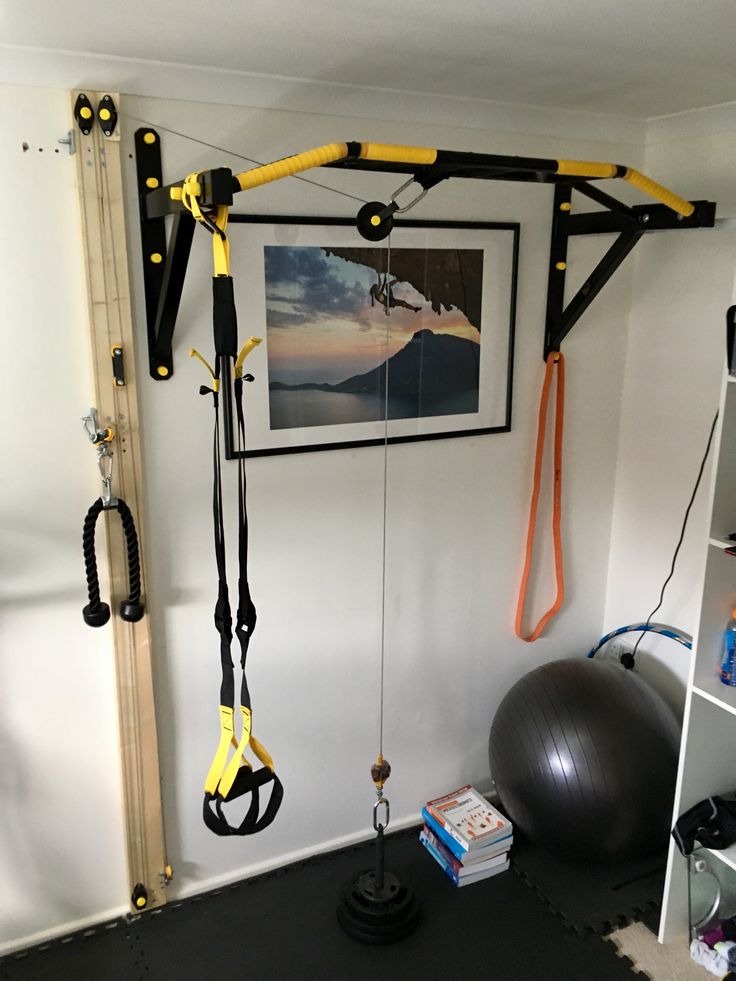 Exercise machines can be of different sizes, shapes and colors, so it will be easy to choose the option for the design of the room.
Exercise machines can be of different sizes, shapes and colors, so it will be easy to choose the option for the design of the room.
Important! Sports equipment must be placed at a sufficient distance from each other - approximately 1.5 meters. During training, there should be no difficulty in using the equipment.
Furniture
The gym should have a corner where you can change clothes, clean up, leave personal belongings. Therefore, it is appropriate to place a small closet or bookcase in the room for storing change of clothes and hygiene items.
The decor should include a sofa, armchair or bench. It is not necessary to organize a full-fledged recreation area. However, designers recommend choosing furniture where you can comfortably sit between exercises.
Tip! The serving table will fit perfectly into the interior of the gym. It will help out if you want to drink tea or have a snack during class.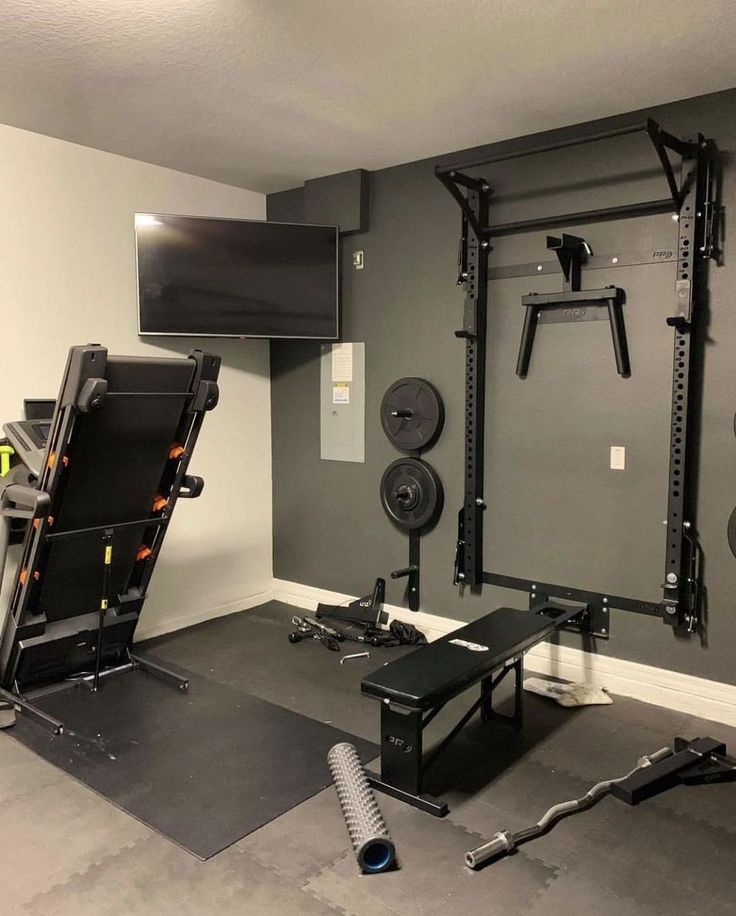
Functional accessories and appliances
Full length mirrors are common in home gyms. Usually designers place them opposite the simulators so that a person looks at himself in the process of exercising. You can organize a mirror wall by sequentially placing several elements on the surface.
Equipment may also be present in the sports room. For example, TV. The attribute will successfully fit into any modern design style.
Exercise equipment in the interior of a home gym
Sports hall lighting in the house and apartment
It is better to organize overhead lighting in the room. Ideal option - track lights. They allow you to adjust the direction of the light fluxes and look great in modern interiors.
Spotlights are also suitable as main light sources. They give a soft diffused light without harsh shadows. Elements can be placed not only on the ceiling, but also on furniture.
If the gym has high ceilings, hanging lamps will also be appropriate.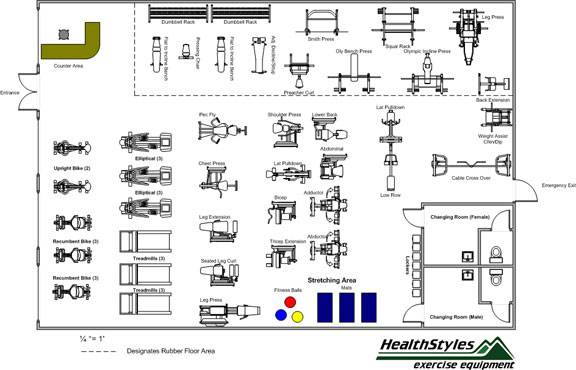 It is better to give preference to round lamps or specimens in metal shades.
It is better to give preference to round lamps or specimens in metal shades.
Tip! Local lighting sources can be placed in the recreation area. For example, several sconces.
Decor in the interior of the gym
The gym is primarily a functional space, so do not overdo it with decorative elements. It is better to pick up a few themed accessories and place them where they will not interfere with classes.
For motivation, hang posters of athletes on the walls. Posters with abstract drawings are also suitable for decorating a room. However, it is worth remembering that the humidity level often rises in the room, so it is better to place accessories under glass.
A few more decor options:
- Wall clock.
- Plaster figures.
- Indoor plants.
If the owner of the gym has medals, certificates and cups, you can arrange special shelves for them. Also, awards will look amazing in a glass case. Such compositions will be both a decor and a great motivation for further achievements.
Tip! An amazing way to decorate your workout room is with a living wall. So called plants planted on a vertical surface. The ensemble of gifts of nature looks like a bright green carpet, effectively contrasting with the design. The decor is not only pleasing to the eye, but also perfectly saturates with oxygen.
Decor in the interior of a home gym
We are pleased to announce that you can order the development of an elite design in our architectural and design bureau. A team of professional designers will fulfill the most exquisite fantasies in your domain!
Interior style for gym design
You can decorate the room in the same style as the rest of the rooms. However, not every direction is suitable for design. Consider win-win options.
Eclecticism
Eclecticism is not an independent direction, but a combination of tendencies of several styles. Designers are given a unique opportunity to experiment with furnishings. The interior may contain features of modern, minimalism, loft, country and even classics.
eclectic style home gym
Chateau
Characteristic features of the home gym interior in the chateau style: an abundance of brown color, laconic lamps, stone and wood finishes, elegant furniture. Bright tones in this direction are practically not found. The original decorative elements act as accents.
Chateau style home gym
Ecostyle
Distinctive features of ecostyle design: wood trim, lack of bright colors in the design, minimum furniture, maximum natural light. Solo tones: white, gray, brown, beige. Wooden beams, original clocks, and wall sculptures are often used as decor.
Eco-style home gym
Classic
Home gym in a classic style is a combination of luxurious furniture, noble shades, beautiful lamps and pendant lamps, exquisite finishes. You can take a bold step and add touches of modern design to the interior ensemble. For example, move away from strict forms of furniture, play with contrasting colors, and refuse to decorate with stucco.
Classic style home gym
Art Nouveau
The design principles of a sports hall in Art Nouveau style are maximum functionality and no unnecessary details. Colors for decor: brown, gray, beige. The design may contain blotches of black.
Art Nouveau home gym
We offer you to see photos of the interiors of gyms in houses and apartments. Works of our specialists:
- Deauville. Gym pool
- Zhukovka. Gym
- Crit. Sports hall
- Classic house. Gym
- Discord. Gym
- Zhedochy. Gym
- Ivanovo. Home gym
- Baku.
Learn more


